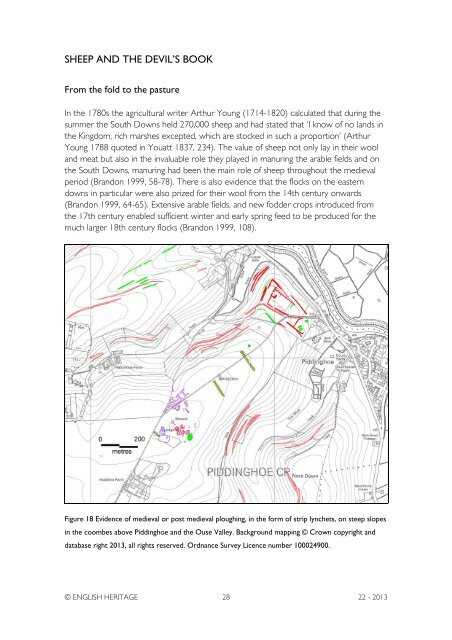Aerial Investigation and Mapping Report - English Heritage
Aerial Investigation and Mapping Report - English Heritage
Aerial Investigation and Mapping Report - English Heritage
You also want an ePaper? Increase the reach of your titles
YUMPU automatically turns print PDFs into web optimized ePapers that Google loves.
SHEEP AND THE DEVIL’S BOOKFrom the fold to the pastureIn the 1780s the agricultural writer Arthur Young (1714-1820) calculated that during thesummer the South Downs held 270,000 sheep <strong>and</strong> had stated that ‘I know of no l<strong>and</strong>s inthe Kingdom, rich marshes excepted, which are stocked in such a proportion’ (ArthurYoung 1788 quoted in Youatt 1837, 234). The value of sheep not only lay in their wool<strong>and</strong> meat but also in the invaluable role they played in manuring the arable fields <strong>and</strong> onthe South Downs, manuring had been the main role of sheep throughout the medievalperiod (Br<strong>and</strong>on 1999, 58-78). There is also evidence that the flocks on the easterndowns in particular were also prized for their wool from the 14th century onwards(Br<strong>and</strong>on 1999, 64-65). Extensive arable fields, <strong>and</strong> new fodder crops introduced fromthe 17th century enabled sufficient winter <strong>and</strong> early spring feed to be produced for themuch larger 18th century flocks (Br<strong>and</strong>on 1999, 108).Figure 18 Evidence of medieval or post medieval ploughing, in the form of strip lynchets, on steep slopesin the coombes above Piddinghoe <strong>and</strong> the Ouse Valley. Background mapping © Crown copyright <strong>and</strong>database right 2013, all rights reserved. Ordnance Survey Licence number 100024900.© ENGLISH HERITAGE 28 22 - 2013

















